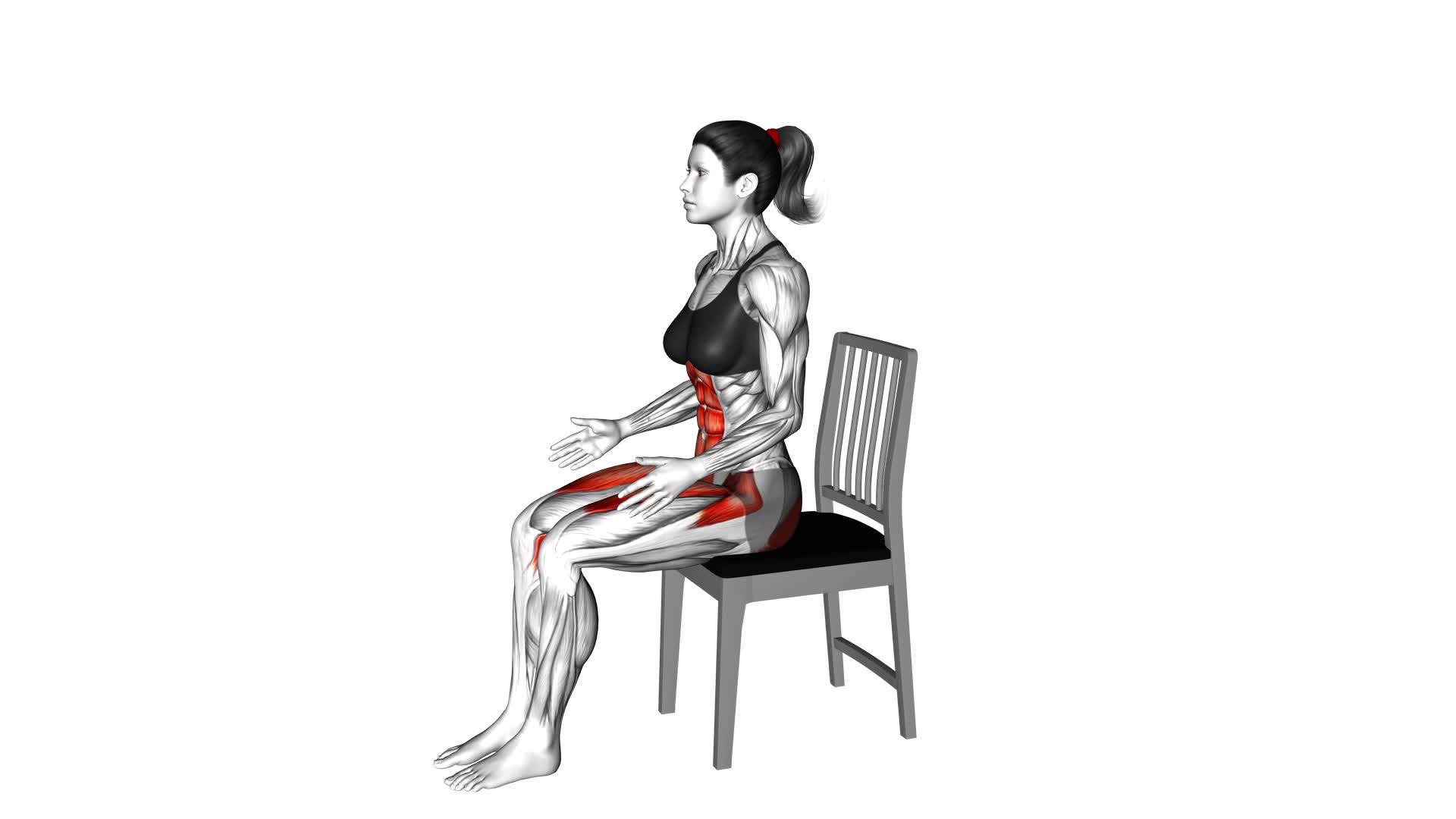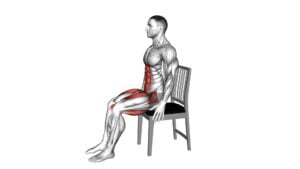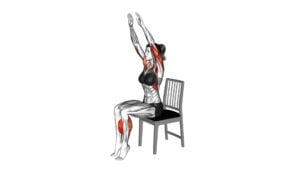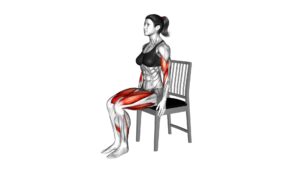Sitting March on a Chair (female) – Video Exercise Guide & Tips

Looking to add an effective seated exercise to your fitness routine? Check out the Sitting March on a Chair!
Watch This Exercise Video
This video exercise guide and tips article is specifically designed for females.
Discover the benefits of this exercise, learn proper form and technique, and find modifications for different fitness levels.
Avoid common mistakes and get ready to incorporate the Sitting March into your workout routine.
Let's get started!
Key Takeaways
- The sitting march on a chair is a convenient option for those with limited mobility or unable to engage in high-impact exercises.
- It provides cardiovascular exercise without excessive stress on joints.
- The exercise improves muscle strength and tone in the quadriceps, hamstrings, and calves.
- Proper form and technique, such as maintaining good posture and engaging the core, optimize effectiveness and reduce the risk of injury.
Benefits of the Sitting March on a Chair
Enjoy the benefits of the Sitting March on a Chair as you engage your muscles and improve your overall fitness. This seated cardio exercise offers numerous health benefits that make it a great addition to your workout routine.
First and foremost, the Sitting March on a Chair provides a convenient option for those who've limited mobility or are unable to engage in high-impact exercises. By performing this exercise while seated, you can still get your heart rate up and enjoy the benefits of cardiovascular exercise without putting excessive stress on your joints.
In addition to being a low-impact exercise, the Sitting March on a Chair also helps to improve your muscle strength and tone. By engaging your leg muscles as you lift and lower your feet, you can strengthen your quadriceps, hamstrings, and calves. This exercise can also help to improve your balance and stability, as you maintain proper form and control throughout the movement.
To maximize the health benefits of the Sitting March on a Chair, it's important to ensure proper form and technique. By maintaining a tall posture, keeping your core engaged, and moving your legs in a controlled manner, you can optimize the effectiveness of the exercise and reduce the risk of injury.
Now that you understand the health benefits of the Sitting March on a Chair, let's dive into the proper form and technique for this exercise.
Proper Form and Technique for the Exercise
Are you ready to learn the proper form and technique for the Sitting March on a Chair exercise? It's important to perform this exercise correctly to maximize its benefits and prevent injury.
Follow these guidelines to ensure proper form and technique:
- Sit on the edge of a chair with your feet flat on the floor and your back straight.
- Place your hands on your hips or hold onto the sides of the chair for support.
- Lift your right foot off the floor, bringing your knee up towards your chest.
- Lower your right foot back down to the starting position and repeat with your left foot.
- Keep your core engaged throughout the exercise to maintain stability and control.
By following these instructions, you'll be able to perform the Sitting March on a Chair exercise with proper form and technique, effectively targeting your leg muscles and improving your balance.
Now, let's move on to the next section where we'll discuss modifications and progressions for different fitness levels, allowing you to tailor this exercise to your specific needs and goals.
Modifications and Progressions for Different Fitness Levels
To modify or progress the Sitting March on a Chair exercise for different fitness levels, you can adjust the range of motion and add resistance as needed. These modifications and variations will help you tailor the exercise to your specific needs and abilities.
For individuals who are just starting out or have limited mobility, you can begin by performing the Sitting March on a Chair exercise with a smaller range of motion. Instead of lifting your knee up high, you can start by simply tapping your foot on the ground in a marching motion. As you gain strength and flexibility, you can gradually increase the height of your knee lift.
To add more challenge and intensity to the exercise, you can incorporate resistance. This can be done by placing a resistance band around your thighs and engaging your leg muscles as you perform the marching motion. The resistance band will provide added resistance, making the exercise more challenging and helping to build strength in your lower body.
Remember to listen to your body and work at a level that's appropriate for you. It's important to start with modifications and progress gradually to avoid injury.
Common Mistakes to Avoid While Performing the Exercise
Avoid these common mistakes when performing the Sitting March on a Chair exercise to ensure you avoid injuries and maximize its effectiveness:
- Slouching: Maintain good posture throughout the exercise by sitting up straight and engaging your core. This will help prevent strain on your back and neck.
- Rushing the movement: Take your time and perform the exercise at a controlled pace. Avoid swinging your legs or using momentum to lift them. This will ensure you're targeting the muscles properly and reducing the risk of injury.
- Neglecting proper alignment: Make sure your feet are flat on the floor and your knees are at a 90-degree angle. Keep your hands resting on the chair for stability. This will help maintain proper alignment and prevent unnecessary stress on your joints.
- Lack of engagement: Focus on actively engaging your abdominal muscles as you lift your legs. This won't only target your core but also help stabilize your body throughout the movement.
By avoiding these common mistakes, you can perform the Sitting March on a Chair exercise safely and effectively.
Now, let's move on to some tips for incorporating this exercise into your workout routine.
Tips for Incorporating the Sitting March Into Your Workout Routine
To incorporate the Sitting March into your workout routine, prioritize engaging your core muscles and maintaining proper alignment. This exercise can be a great addition to your cardio routine, as it helps increase your heart rate while also targeting your lower body muscles.
When performing the Sitting March, it's crucial to maintain proper posture throughout the exercise. Start by sitting on a chair with your feet flat on the floor and your back straight. Keep your shoulders relaxed and avoid slouching. Engage your core by pulling your belly button in towards your spine. This will help stabilize your body and prevent any unnecessary strain on your lower back.
As you begin the exercise, lift one foot off the ground and march in place. Make sure to keep the movement controlled and controlled. Focus on lifting your knee as high as you comfortably can, while still maintaining proper posture.
To make the Sitting March more challenging, you can add arm movements. For example, you can swing your arms in coordination with your legs, or you can hold a small weight or resistance band to increase the intensity.
Frequently Asked Questions
How Many Calories Does the Sitting March on a Chair Burn?
The sitting march on a chair is a great exercise for calorie burning and has many health benefits. It's a simple yet effective way to get your heart rate up and burn calories.
By engaging your leg muscles and moving your arms, you can increase your calorie burn even more. This exercise is also beneficial for improving circulation and strengthening the muscles in your lower body.
Can the Sitting March on a Chair Help Improve Posture?
The sitting march on a chair can be a beneficial exercise for improving posture. By engaging your core muscles and practicing proper alignment, this exercise can help strengthen the muscles that support your spine and promote an upright posture.
Additionally, the sitting march can also improve balance by challenging your stability while performing the marching motion. Incorporating this exercise into your routine can contribute to better posture and overall body alignment.
Is It Necessary to Warm up Before Doing the Sitting March on a Chair?
Before engaging in the sitting march on a chair, it's important to warm up your body with some simple exercises. Warming up helps to prepare your muscles and joints for the movements involved in the sitting march. Additionally, it increases blood flow and flexibility, reducing the risk of injury.
The sitting march on a chair itself has numerous benefits, such as improving leg strength, promoting better circulation, and enhancing overall posture. So, take a few minutes to warm up before starting this exercise for optimal results.
Can the Sitting March on a Chair Help With Weight Loss?
The sitting march on a chair can be a beneficial exercise for weight loss. By engaging your leg muscles and increasing your heart rate, it helps to burn calories and improve cardiovascular health.
Additionally, it provides a low-impact option for those with mobility limitations or joint pain. If you're looking for alternative chair exercises, you can try seated leg raises or chair squats.
Remember to consult with a healthcare professional before starting any new exercise routine.
How Often Should I Include the Sitting March on a Chair in My Workout Routine?
To determine the optimal workout frequency for including the sitting march on a chair in your routine, consider your fitness level and goals. Beginners may benefit from starting with 2-3 sessions per week and gradually increasing to 4-5 as they become more comfortable.
Remember to listen to your body and make modifications as needed.
The sitting march on a chair is a versatile exercise that can help improve cardiovascular health and strengthen leg muscles.
Conclusion
Incorporating the sitting march on a chair into your workout routine can provide numerous benefits. This exercise is great for improving leg strength, cardiovascular fitness, and overall mobility.
To maximize the effectiveness of the sitting march, it's important to maintain proper form and technique. This means keeping your back straight and core engaged throughout the movement.
Additionally, it's important to make modifications to suit your fitness level. If you're just starting out, you can begin by marching in place while seated. As you progress, you can increase the intensity by lifting your knees higher and increasing the speed of the movement.
Avoid common mistakes, such as slouching or rushing through the movement. Slouching can put unnecessary stress on your back, while rushing through the movement can compromise your form and lead to injury.
With these tips and guidance, you can confidently add the sitting march to your fitness regimen for optimal results. Take your time, focus on proper form, and gradually increase the intensity as you get stronger. Remember to listen to your body and make adjustments as needed.

Author
Years ago, the spark of my life’s passion ignited in my mind the moment I stepped into the local gym for the first time. The inaugural bead of perspiration, the initial endeavor, the very first surge of endorphins, and a sense of pride that washed over me post-workout marked the beginning of my deep-seated interest in strength sports, fitness, and sports nutrition. This very curiosity blossomed rapidly into a profound fascination, propelling me to earn a Master’s degree in Physical Education from the Academy of Physical Education in Krakow, followed by a Sports Manager diploma from the Jagiellonian University. My journey of growth led me to gain more specialized qualifications, such as being a certified personal trainer with a focus on sports dietetics, a lifeguard, and an instructor for wellness and corrective gymnastics. Theoretical knowledge paired seamlessly with practical experience, reinforcing my belief that the transformation of individuals under my guidance was also a reflection of my personal growth. This belief holds true even today. Each day, I strive to push the boundaries and explore new realms. These realms gently elevate me to greater heights. The unique combination of passion for my field and the continuous quest for growth fuels my drive to break new ground.







